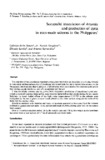Successful inoculation of Artemia and production of cysts in man-made salterns in the Philippines
- Global styles
- MLA
- Vancouver
- Elsevier - Harvard
- APA
- Help
Share
Abstract
The objective of the inoculation described in this paper was to test the feasibility of culturing Artemia in man-made earthen salterns and of producing adults and cysts for use in aquaculture projects in the Philippines. San Francisco Bay (California, USA) Artemia were inoculated in two concrete tanks and in four earthen ponds which are part of a small local salt factory.
It was found that Artemia can be grown (with continuous production of nauplii and cysts) year-round in covered concrete tanks and in open concrete tanks and earthen ponds during the dry season (February to June). Lethal effects of too high water temperatures (>35°C) to the cultures were anticipated by the use of green coconut fronds placed on the water surface alongside the walls of the tanks and the earthen dikes.
Rice bran enriched with vitamins and traces of minerals appeared to be a good food for Artemia cultured in aerated concrete tanks; in the earthen salt ponds the brine shrimp grew well on the natural food present.
Over a 3 month production period, 26 kg dry weight cysts and 150 kg live weight adults have been harvested from a total surface of 1.7 ha of salt ponds and brine tanks.
Description
ALSO IN: Quarterly Research Report / SEAFDEC. Aquaculture Department, 3(1):19-20 1979.
Suggested Citation
de los Santos Jr., C., Sorgeloos, P., Bernardino, A., & Laviña, E. M. (1980). Successful inoculation of Artemia and production of cysts in man-made salterns in the Philippines. In G. Persoone, P. Sorgeloos, O. Roels, & E. Jaspers (Eds.), The Brine Shrimp Artemia. Proceedings of the International Symposium on the brine shrimp Artemia salina, Corpus Christi, Texas, USA, August 20-23, 1979. (Vol. 3. Ecology, Culturing, Use in Aquaculture, pp. 159–163). Wetteren, Belgium: Universa Press.
Type
Conference paperKoleksi
- Conference Proceedings [298]


